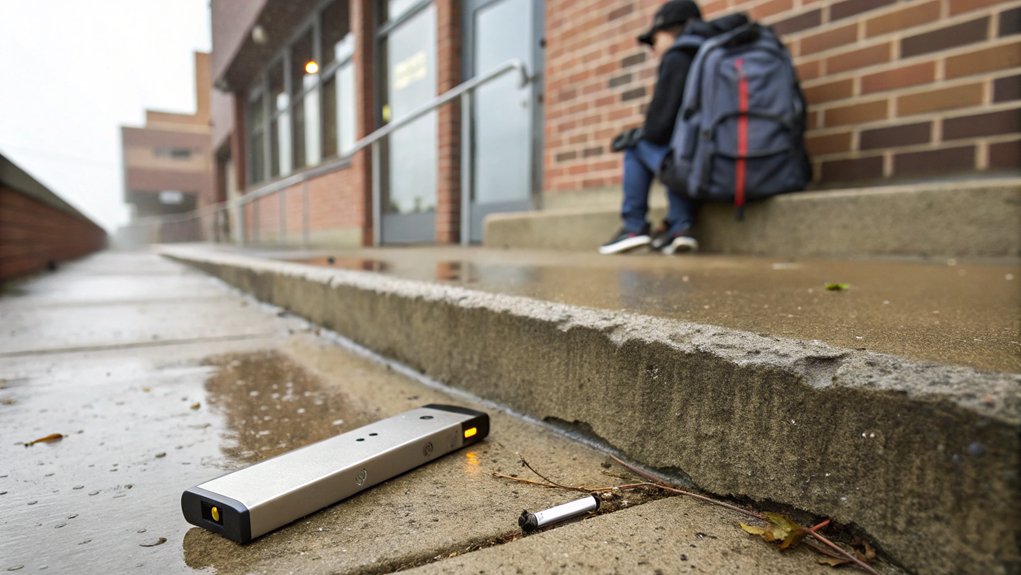Cheshire residents face soaring housing costs and vanishing services after government overhaul. Is your family's welfare at risk? Local communities struggle as policy changes reshape the county's future.
In spite of recent declines, underage vaping remains a significant concern in the U.S., with over 1.63 million young users and e-cigarettes as their preferred nicotine delivery method. While the legal purchasing age is 21, only 33% of vape shops consistently verify IDs, allowing minors to easily obtain products through stores, online purchases, and peer networks. You'll find that current enforcement mechanisms are largely ineffective, leading legislators and community stakeholders to push for stricter penalties and improved compliance measures.
While teen vaping rates have shown recent declines, the underage use of e-cigarettes remains a pressing public health concern, with over 1.63 million young people currently using these products. The latest data reveals that 8.1% of students report current tobacco use, with high school students showing higher rates at 10.1% compared to middle school students at 5.4%. E-cigarettes continue to dominate as the preferred nicotine delivery method among youth, followed by nicotine pouches and traditional cigarettes.
Recent surveys indicate that cigarette smoking rates have plummeted to 1.4% among students, marking a historic low in youth tobacco use.
You'll find that the health implications of underage vaping are particularly concerning, as nicotine can greatly impact adolescent brain development. Research has shown that young vapers face increased risks of respiratory issues and may experience negative effects on attention, learning, and memory.
Studies have additionally identified a troubling connection between vaping and mental health challenges, with users reporting higher rates of depression and suicidal thoughts compared to their non-vaping peers.
The enforcement of age restrictions presents a major challenge in addressing this crisis. Current data shows that only 33% of vape shops consistently check IDs, making it relatively easy for minors to purchase these products directly from stores.
You'll see that teens often obtain vaping devices through various channels, including online purchases and peer networks, in spite of existing laws prohibiting sales to minors.
Social media's influence has played a vital role in the spread of vaping among youth. E-cigarette companies have utilised influencer marketing to create appealing content that resonates with young audiences, leading to widespread misconceptions about vaping safety.
Young people frequently turn to social media platforms for information about vaping, where they encounter content that normalises this behaviour.
Legislative efforts are intensifying to address these challenges, with a focus on raising the legal purchasing age to 21 and implementing stricter enforcement measures.
Nevertheless, you'll need to understand that current penalties and enforcement mechanisms haven't effectively deterred underage sales or use. The combination of inadequate age verification, widespread social media influence, and challenges in enforcement has created a complex problem requiring a multi-faceted solution.
Parents and educators are now encouraged to take a more active role in understanding and addressing these influences, particularly on social media platforms where vaping content proliferates.
The ongoing crisis demands stronger collaboration between legislators, law enforcement, and community stakeholders to protect young people from the risks associated with early nicotine exposure and addiction.
Most-Asked Questions FAQ
Can Parents Be Held Legally Responsible if Their Child Is Caught Vaping?
You typically won't be held legally responsible if your child is caught vaping, unless you actively provided vaping materials or knowingly facilitated their behavior. You could face charges under child endangerment laws in those cases.
What Chemicals in Vaping Products Are Most Harmful to Teenage Brain Development?
You'll find nicotine is the most harmful chemical in vaping products for your teenage brain, disrupting your learning, mood, and impulse control. Other toxic compounds like metal particles and flavoring chemicals compound these effects.
How Can Schools Effectively Detect and Prevent Vaping in Bathrooms?
You can install smart vape detectors in bathrooms that'll alert staff to chemical signatures. Combine this with regular monitoring, clear consequences, and bathroom pass systems to effectively prevent students from vaping in these spaces.
Are There Rehabilitation Programs Specifically Designed for Teenage Vaping Addiction?
You'll find specialised programs like Caron's Project CONNECT® that offer teen-focused vaping cessation support. You can furthermore access online counselling, group therapy, and educational resources designed specifically for teens struggling with nicotine addiction.
